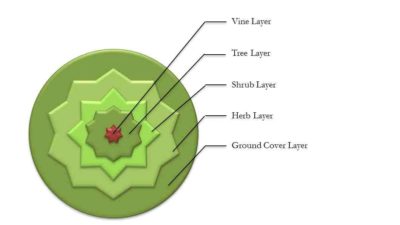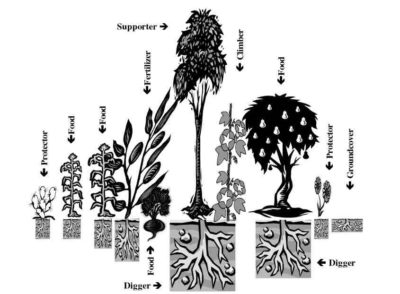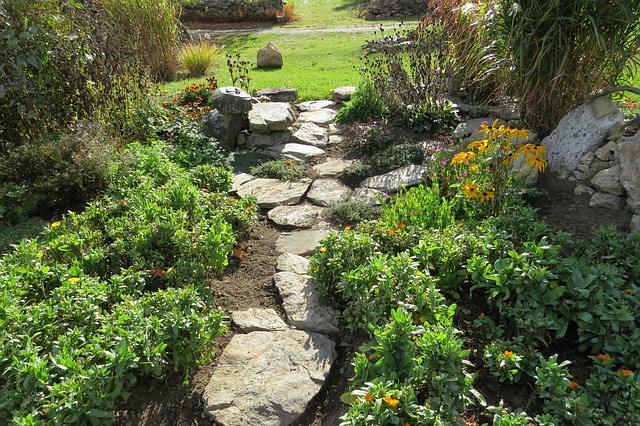You’ve been gardening for years, and have mastered the art of growing food on your homestead. You do it organically, without using commercial pesticides and fertilizers. You save your own seeds, can your own produce, and are practically self-sufficient.
But in the event of a local or nationwide disaster that closes stores and causes people to become desperate, how are you going to protect your garden from potential thieves? Sure you could be generous and help a number of people for a while, but you can’t possibly feed each every individual that shows up at your door every time.
If you want to play it safe and make your garden “invisible” from unwanted elements, turn it into a “secret garden” with planting guilds.
A guild is a design principle in permaculture that groups assorted plants together, usually in a circle, surrounding a central plant. Each plant is carefully chosen to complement the others, ensuring each other’s growth. Like forests, guilds mimic the wilderness by having multiple layers of diverse vegetation: trees, shrubs, vines, herbs, root crops, ground cover, and even animals, insects and beneficial microorganisms. All of these work together to meet the four basic needs of plants: food (mostly in the form of nitrogen), mulch, pollination and protection. A guild is an ecosystem in itself, with different members in symbiotic relationship with one another. On a larger scale, a forest garden, also known as a “food forest,” is a great example of a guild.
Get The Best Deals On Non-GMO Seeds Right Here!
I first heard about guilds after watching a video of renowned natural farmer Sepp Holzer, who grew a food forest in the mountains of Austria. He cultivated a sundry mix of fruits, flowers, legumes, corn, buckwheat, herbs and spices, pumpkins, salad greens, medicinal plants and different kinds of root crops all across his acreage. He didn’t plant them in neat rows, but scattered seeds at random and just let nature do its course. Guild-planting, he says, makes the garden so much more dynamic, abundant and efficient. In fact, the yield in his food forest in the Appalachians is five times more than it would be if he did traditional row gardening.
 The benefits of guilds are undeniable: less or practically no irrigation, no mulching, no commercial pesticides and fertilizers and, ultimately, minimal maintenance. You get high yields from a very small space. And, because food forests look like a wild, untended, neglected hodge-podge of overgrown bush, nobody will think it’s a virtual paradise brimming with food! Even animals and pests would have a hard time fighting an array of repellents to get through to your goods.
The benefits of guilds are undeniable: less or practically no irrigation, no mulching, no commercial pesticides and fertilizers and, ultimately, minimal maintenance. You get high yields from a very small space. And, because food forests look like a wild, untended, neglected hodge-podge of overgrown bush, nobody will think it’s a virtual paradise brimming with food! Even animals and pests would have a hard time fighting an array of repellents to get through to your goods.
Here are the different layers to plant in a guild:
1. Trees. In a guild, the trees are strong, deep-rooted plants that reach deep under the ground to absorb minerals and bring them up to the surface. They’re the canopy layer, dominating but not saturating the surrounding plants. They provide shelter for smaller trees and shrubs, beneficial animals and insects. The trees grown in the center of guilds are normally fruit or nut trees. In the northern states, they’re most likely apples, pears, cherries, plums and figs; in the subtropics, citruses like oranges, limes and lemons.
2. Shrubs. Shrubs provide a windbreak to reduce stress on your central tree. They can be low or understory fruit trees like bananas and papayas, stalks like corn, various woody perennials and most berry bushes. Comfrey, borage and dandelion are good because they’re “miners” – they collect nutrients from the soil, store it in their leaves and feed it to surrounding plants when they shed their leaves. You can also chop-and-drop them to use as green manure.
Story continues below video
3. Vines. Vines make up the vertical layer that climb up the central and understory trees. They need little soil and ground space to thrive, but they require physical support from stronger plants beside them. Vines provide much food in less space, not just for humans but also for surrounding plants since they are nitrogen-fixers – they absorb nitrogen from the air and make them bio-available for surroundings plants. Examples of good leguminous vines are lima and runner beans. Annual climbers that seed themselves easily are gourds like cucumbers and squashes. Other edible vines are honeysuckle, jasmine, bramble, passionflower and of course, grapes.
4. Herbs and flowers. Herbs and flowers protect the fruits and nuts in your guild. Spices like peppers and herbs from the allium family like chives and onions ward off harmful insects. Even mice are said to be repelled by chives. On the other hand, fennel and dill attract wasps that prey on those harmful insects. Flowers, for their part, mostly attract pollinators, but certain ones draw predator insects: those from the daisy family, the Umbelliferae family when flowering (carrots, parsley, celery), yarrow and allysum. Marigolds, nasturtiums, lavender, tansy, elderberry, wormwood and peppermint geraniums are known pest repellents, while daffodils are said to keep deer at bay.
The thing to remember is that pests are attracted through sight and smell. Having an assortment of flowers, whether pungent-smelling or aromatic, will give mixed signals and confuse them. Other plants that can protect your guild from bigger animals and unwanted folks are thorny ones like cacti and osage orange.
 Speaking of protection, try attracting beneficial animals, too, like frogs, lizards and birds, or keep ducks or guinea fowl to control slugs. They’re natural predators. Put up birdhouses or consider building a pond to help attract these garden friends. The key is to simulate a balanced natural ecosystem so the different elements can regulate each other’s growth.
Speaking of protection, try attracting beneficial animals, too, like frogs, lizards and birds, or keep ducks or guinea fowl to control slugs. They’re natural predators. Put up birdhouses or consider building a pond to help attract these garden friends. The key is to simulate a balanced natural ecosystem so the different elements can regulate each other’s growth.
5. Ground cover – Ground cover plants protect the soil around the guild from too much sun, and reduce erosion during heavy rains and strong winds. They are your living mulch, building the soil while smothering unwanted weeds. They hold moisture and nutrients in the soil, keeping beneficial microorganisms underneath happy. They are usually in the form of grasses, legumes and brassicas. Ground covers that are wonderful nitrogen-fixers are comfrey, alfalfa, hairy vetch, field peas, soybeans and clovers. Other great edible cover crops are oats, barley, rye, buckwheat, canola, flax, rapeseed, spelt, spinach, mustards, strawberries, globe artichokes, parsnips, radishes, fava beans, fenugreek, chamomile, nasturtiums, elderberry, dandelions, sunflower and chicory.
6. Rhizomes — These are root crops that are diligent diggers: white and sweet potatoes, carrots, beets, yams, daikon radish, and edible tubers like turnips, Jerusalem artichokes, cassava and yacon. They loosen compacted soil, make it soft, and mine nutrients underground. In the level which they belong to, called the rhizosphere, permaculturists like to include beneficial organisms like worms, insects and fungi.
For a comprehensive list of edibles you can plant in your food forest, click here.
As you can expect, you’ll have to prioritize growing perennials so you won’t have to sow and pull out parts of your garden year after year. Use open-pollinated heirloom seeds, and just let them go to seed to replenish themselves. And remember: The more diversity you have, the greater the variety and nutrients on your plate … and, the more confusion and camouflage you’ll create for both pests and people.
What advice would you add? Share your tips in the section below:
Every Spring, Gardeners Make This Avoidable Mistake — But You Don’t Have To. Read More Here.
 Off The Grid News Better Ideas For Off The Grid Living
Off The Grid News Better Ideas For Off The Grid Living




